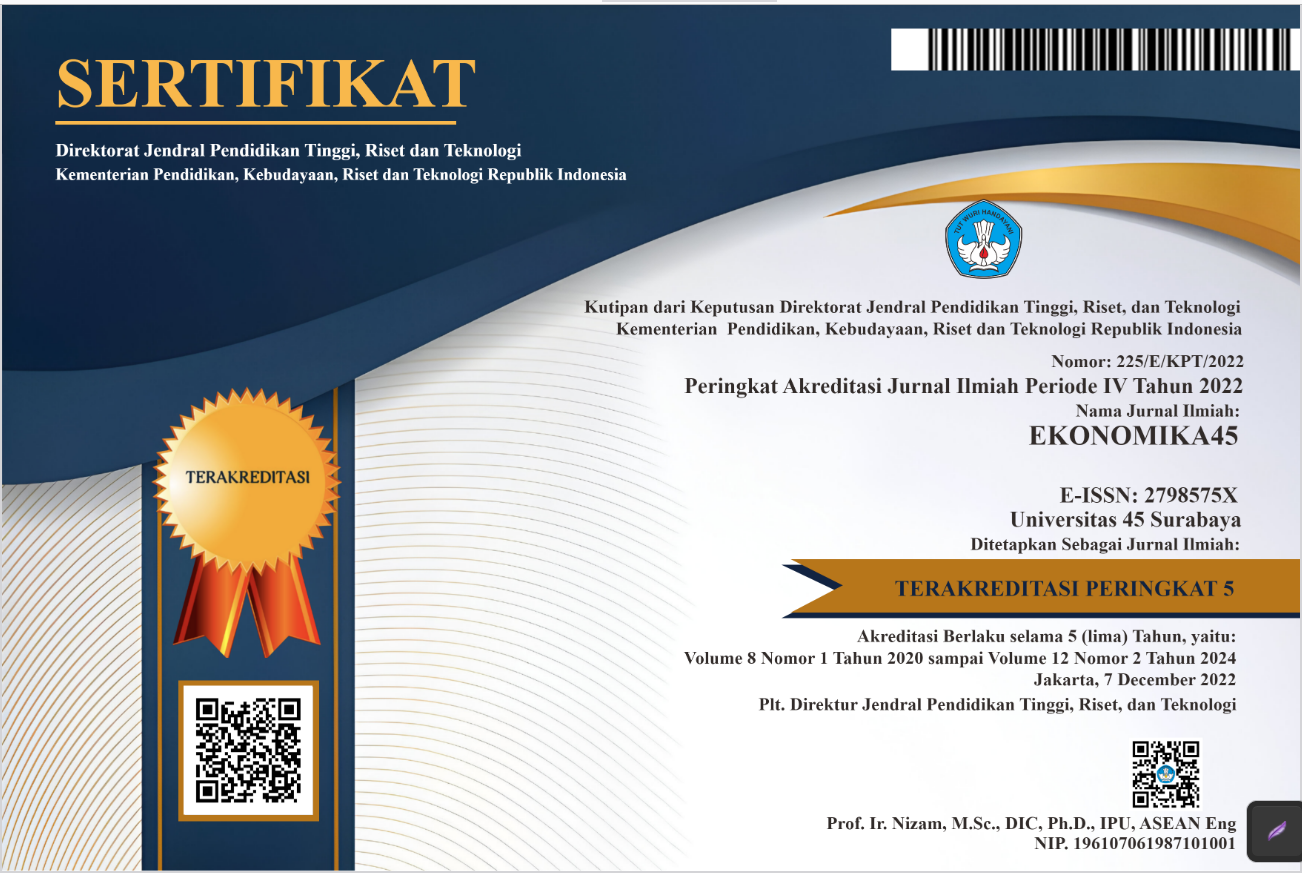Respon Ekspor Akibat Shock Nilai Tukar Dan Jumlah Uang Beredar di Indonesia
DOI:
https://doi.org/10.30640/ekonomika45.v11i1.1099Keywords:
Export rate, exchange rate, money supply, VECM methodAbstract
The rupiah exchange rate against the US dollar has always fluctuated, due to the instability of economic conditions both at home and abroad. The macroeconomic conditions of the two countries have an influence on the level of exports, especially in Indonesia. The response to export developments that occur in the country is not only influenced by the rupiah exchange rate with the dollar, the money supply (JUB) in Indonesia is also related to the level of exports that occur. If the JUB increases, the number of exports will also increase. So that the relationship between exports, exchange rates, and the money supply has a close relationship with the country's economic conditions. This study aims to analyze how the response in the level of exports in Indonesia is related to the shocks that occur in the exchange rate between the rupiah and the dollar, and also to the money supply in Indonesia through several variable data such as exports, exchange rates, inflation, BI rate, and money. circulating (M2), using data for 2018:M1-2022:M12 using the Vector Error Correction Model (VECM) analysis method. The results show that the response to inflation (INF), the exchange rate (KURS), the money supply (M2), and the bi rate on exports in Indonesia show that the variable response results are positive and the average is stable.
References
Amir M.S. (1999). Ekspor Impor : Teori & Penerapannya. PT. Pustaka Binaman Pressindo.
Badan Pusat Statistik. (2023). Inflasi. https://www.bps.go.id/subject/3/inflasi.html
Bank Indonesia. (2020a). BI-7 Day Reverse Repo Rate (BI7DRR). Www.Bi.Go.Id. https://www.bi.go.id/id/fungsi-utama/moneter/bi-7day-rr/default.aspx
Bank Indonesia. (2020b). Inflasi. Www.Bi.Go.Id. https://www.bi.go.id/id/fungsiutama/moneter/inflasi/default.aspx
Bank Indonesia. (2020c). Perkembangan Uang Beredar. Bi.Go.Id. https://www.bi.go.id/id/publikasi/laporan
Bustami dan Paidi Hidayat. (2013). ANALISIS DAYA SAING PRODUK EKSPOR PROVINSI SUMATERA UTARA. Ekonomi Dan Keuangan, 1, 1–17.
Kalaitzi, A. S., & Chamberlain, T. W. (2020). Exports and Economic Growth: Some Evidence from the GCC. International Advances in Economic Research, 26(2), 203– 205. https://doi.org/10.1007/s11294-020-09786-0
Kementerian Keuangan Dirjen Bea dan Cukai. (2013). Ekspor. Beacukai.Go.Id. https://www.beacukai.go.id/arsip/pab/ekspor.html
Kementerian Perdagangan. (2023). Panduan Ekspor. Djpen.Kemendag.Go.Id. http://djpen.kemendag.go.id/app_frontend/links/65-panduan-ekspor
Mohsen, A. S. (2015). Effects of Exports and Investment on the Economic Growth in Syria. International Journal of Management, Accounting and Economics, 2(6), 527– 538.
Muritala, T. (2011). Investment , Inflation and Economic Growth : Empirical Evidence from Nigeria. 2(5), 68–77. https://doi.org/10.5829/idosi.ijee.2012.03.04.121204
Rahardja, P. dan M. M. (2008). Pengantar Ilmu Ekonomi : Mikroekonomi Dan Makroekonomi (3rd ed.). Lembaga Penerbit Fakutas Ekonomi Universitas Indonesia.
Setyorani, B. (2018). Pengaruh nilai tukar terhadap ekspor dan jumlah uang beredar di indonesia. Forum Ekonomi, 20(1), 1. https://doi.org/10.29264/jfor.v20i1.3307
Downloads
Published
How to Cite
Issue
Section
License
Copyright (c) 2023 EKONOMIKA45 : Jurnal Ilmiah Manajemen, Ekonomi Bisnis, Kewirausahaan

This work is licensed under a Creative Commons Attribution-ShareAlike 4.0 International License.









